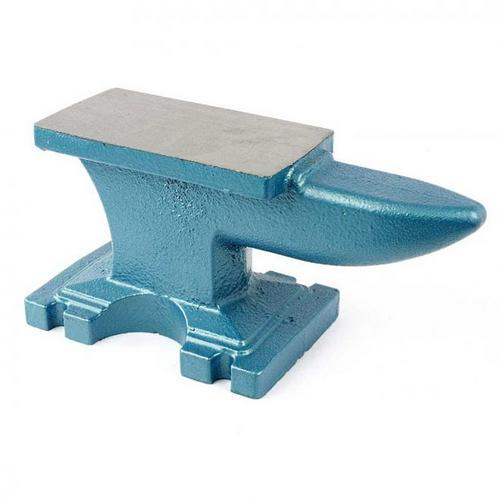
Europeans are also keen on double horned anvils (one conical, one pyramidal). Currently European anvils are big on an added block on one side of the anvil extending to the base called an upsetting block. Formerly, Hay-Budden produced a Farriers anvil that was their standard anvil with one corner of the table removed and two pritchel holes (one extra). Today's American made Farriers Anvil has a very narrow waist (approx equal to the face width) and exaggerated horn and heal. V-grooves ground in the face are also offered. Specialty anvils such as the Farriers anvil sometimes have a bulge to one side of the horn for forging caulks. It includes "Acme" (probably Hay-Buden) steel faced wrought iron anvils, "Steel Face Cast Anvils" and "Chilled Face Cast Iron Anvils." Weights range from 220 pounds to 20 pounds.

In 1985 the same catalog was reprinted a second time in cooperation with A.B.A.N.A. In 1984 the Mid-West Tool Collectors reprinted the 1915 Sears, Roebuck and Co., Tools Machinery Blacksmith's Supplies catalogue. Reprints of catalogs such as old Sears and Roebucks are also a good source of anvil data. This catalog also included a variety Blacksmith's hand tools and forges. "The face is made from one piece of high grade tool steel, accurately ground and tempered.

Industrial Supply Corp., Richmond, VA, 1955 catalog, page 172 lists Fisher "Eagle" Anvils from 50 to 700 pounds, Old industrial catalogs will often include photos and specs of the anvils they carried. The most beautifully illustrated book about Blacksmithing that I've ever seen. Then try Eric Sloane's A Museum of Early American Tools, pp.90-93 Early, Colonial, Stake, Nailers.Īnd for a classic of custom design see Otto Schmirler's

Start with Bealer's classic The Art of Blacksmithing, p.65 Medieval Anvils, p.66 The London Anvil and nomenclature, p.68 A Liêges anvil. Today there are still a number of manufactures making anvils but in small quantities and there are still organizations and individuals that make anvils to suit themselves.Īny book on blacksmithing will give the shape and basic nomenclature. Other than this brief period anvils were made in a great variety. Most anvils were made in the London pattern or it's modification the American pattern (narrower waist, mass moved into horn and heal). First, one should recognize there is no "standard" anvil.ĭuring the early part of the twentieth century, shortly before the automobile and other technical advances put the American Blacksmith out of business, anvils were made in great quantity and under great competition.


 0 kommentar(er)
0 kommentar(er)
